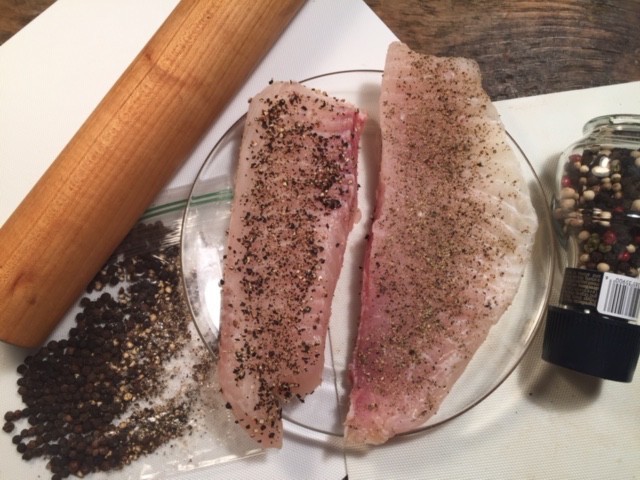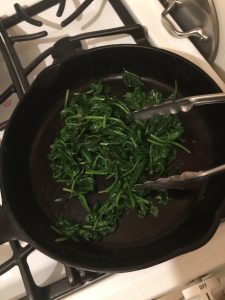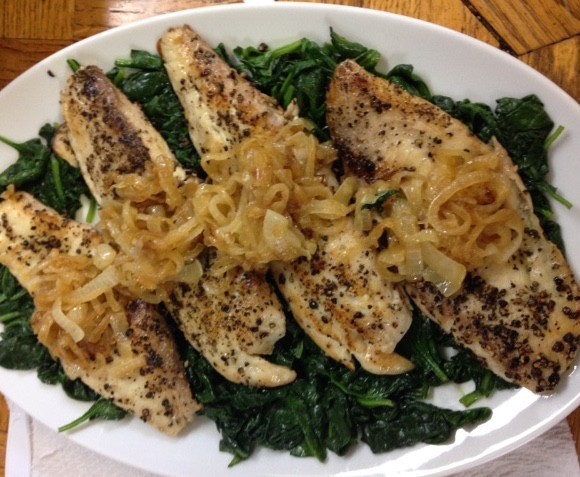“Let’s keep it nice and easy.” I’m with Frank Sinatra on this, in cooking as well as in love. To give fish big flavor, pan-searing filets coated with crushed black peppercorns is as nice and easy as it gets. Good for salmon and swordfish, it turns even bland tilapia into a treat. (Chicken cutlets and a lean cut of beef like iron steak like it as well.)
Chefs who obsess about ingredients go on about salt, specifying when to choose coarse or fine-grained salt and whether to use kosher, sea salt—and from which waters—or pink salt from the Himalayas. On pepper, “freshly ground” is pretty much all they say.
Grinding peppercorns just before using ground pepper actually is best. Whole peppercorns stored in an airtight jar keep their flavor for a year or more while the substances that give pepper biting heat, flowery aroma and its woodsy disappear quickly once the grains are ground or smashed.
Black peppercorns, the berry of the piper nigrum vine, are native to India. Black Tellicherry pepper from the Malabar coast of southern India is the most familiar. Here, though, I like using even more pungent peppercorns from Rajakumari, which is further inland. They show how, when a single spice is the main flavor for a dish, splurging on a special quality is worth the cost.
Peppering the fish is nice and easy. Simply slip the peppercorns into a resealable plastic sandwich bag and hammer them with a mallet or crush them using a rolling pin. Then press the pepper into the tilapia.
 Meals made using one pan make cleanup nice and easy. So I encrust the fish with the pepper and set it aside while using a skillet to sauté baby spinach. Then, I use the same pan to brown the onions. While serving as a second vegetable, the creamy, soft onions are more like a condiment when spooned over the cooked fish.
Meals made using one pan make cleanup nice and easy. So I encrust the fish with the pepper and set it aside while using a skillet to sauté baby spinach. Then, I use the same pan to brown the onions. While serving as a second vegetable, the creamy, soft onions are more like a condiment when spooned over the cooked fish.
Using enough oil is essential both to keep food from sticking and also because in sautéing, oil seals moisture inside vegetables, which helps them soften. To see how this works, coat a skillet with cooking spray, add chopped onions, hit them with a little more spray, and sauté them until they are golden. Then wipe out the pan, add 2 tablespoons of olive oil, sauté another onion, and compare the differences in texture and taste.
 Here I use a “cheat” by oiling the spinach and the onions before they go into the pan. In a bowl, I combine them with one tablespoon of oil and toss to coat them. Using a well-seasoned cast-iron skillet, I then just sauté away, not adding any oil to the pan. If, however, the pan is not well-seasoned, I give it a quick shot of cooking spray. This method it also works with some proteins—you’ll need to experiment as results vary with different pans.
Here I use a “cheat” by oiling the spinach and the onions before they go into the pan. In a bowl, I combine them with one tablespoon of oil and toss to coat them. Using a well-seasoned cast-iron skillet, I then just sauté away, not adding any oil to the pan. If, however, the pan is not well-seasoned, I give it a quick shot of cooking spray. This method it also works with some proteins—you’ll need to experiment as results vary with different pans.
To serve, spread the spinach in a bed, set the cooked tilapia on top of it, then smother the crusty fish with onions. This is the presentation a chef would use, and it is nice and easy.
Here’s the full recipe: Peppered Tilapia with Caramelized Onions and Wilted Spinach






